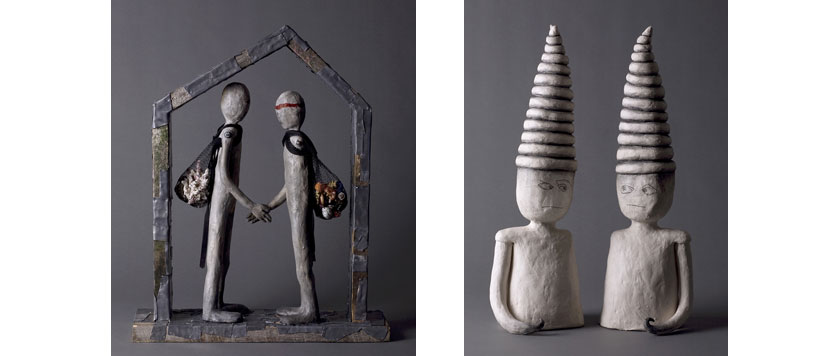To me they are more the same than different. Milton Glasser takes as much joy in seeing his design for a commercial clock mass-produced as I do making a one-of-a-kind piece of sculpture. The more I thought about this admittedly loaded question the more I feel it should be recast through the lens of the nature of artistic collaboration.
I currently have on view in NYC an exhibition entitled THE TALKING CURE. “The Talking Cure," takes its name from Sigmund Freud’s original description of psychoanalysis. The exhibition consists of twelve mixed material sculptures, each accompanied by an interactive audio track created by a literary collaborator. I asked twelve writers- poets, novelists, screenwriters, and playwrights- to each chose a sculpture to which they relate most intimately. Each wrote his or her imagined monologue in the sculpture's mind. Actors then transformed the written work into audio recordings. When the viewer points a Smartphone, Blackberry or I-Phone reading device at the QR tag accompanying each sculpture, it triggers audio to hear the inner voice of the artwork. There is also a recording station at the gallery, at which anyone can record his or her own monologue for one of my sculptures, and I will make a sculpture from the monologue. From image, to words, to words to image, it brings it all full circle.
 For me the core of this project is about “letting go,” on several levels. When I asked the twelve writers to imagine a monologue for of my sculptures, my own story, motivation and artistic universe yielded to theirs. The writers in turn had to let go of their written work when the actors were given the monologues to interpret for recording. Like the process of psychotherapy, which is in theory about letting go, we each had to both create and then let that creation go out into world. I was delighted and amazed by the works that my literary collaborators produced. A few of the writers had a little more trouble letting go of their words and more than one actor was uneasy with their “reading” of the text. It’s been a fascinating experience in creation and psychology.
For me the core of this project is about “letting go,” on several levels. When I asked the twelve writers to imagine a monologue for of my sculptures, my own story, motivation and artistic universe yielded to theirs. The writers in turn had to let go of their written work when the actors were given the monologues to interpret for recording. Like the process of psychotherapy, which is in theory about letting go, we each had to both create and then let that creation go out into world. I was delighted and amazed by the works that my literary collaborators produced. A few of the writers had a little more trouble letting go of their words and more than one actor was uneasy with their “reading” of the text. It’s been a fascinating experience in creation and psychology.
Fine art can be thought of as the art of highly individual expression placed before a broader public. It is meant to express the soul of the artist, and it hopes to reach the hearts and minds of an audience, sometimes a highly select one. Commercial art could be defined as art- or production work- made for the masses, attempting to excite or interest the individual. At the core of both activities is a willing collaboration between artist and audience, often with a host of intermediaries in between- from gallery or manufacture, to distributor, marketer, ad agency or art critic, each a part of the artistic food chain. My latest work- an exhibition of fine art on which I collaborated with myriad writers, actors, and technology partners- explores- indeed toys with- the notion of collaboration, the disappearing distinction between audience and artist, and the blurred line between fine art and group production.
It‘s this act of “letting go” that is the critical element in any creative act, whether fine art or commercial. It’s the one thing that makes or breaks any work of art, be it made for a client or to express ones purest inner feelings. It’s that actor who lets it rip in a performance, the writer who is unafraid to be emotionally naked on the page, the graphic designer who goes outside of the box to solve a creative problem and yes, the visual artist who able and willing to share the world inside their head with the rest of us.
- Artist Melissa Stern www.melissa-stern.com
The exhibition is up until Dec. 22- Smart Clothes Gallery 154 Stanton St ( corner of Suffolk, one block below Houston) Wed- Sun, 12- 6:30 or by appointment. 212.627.3276 smartclothesgallery.com

